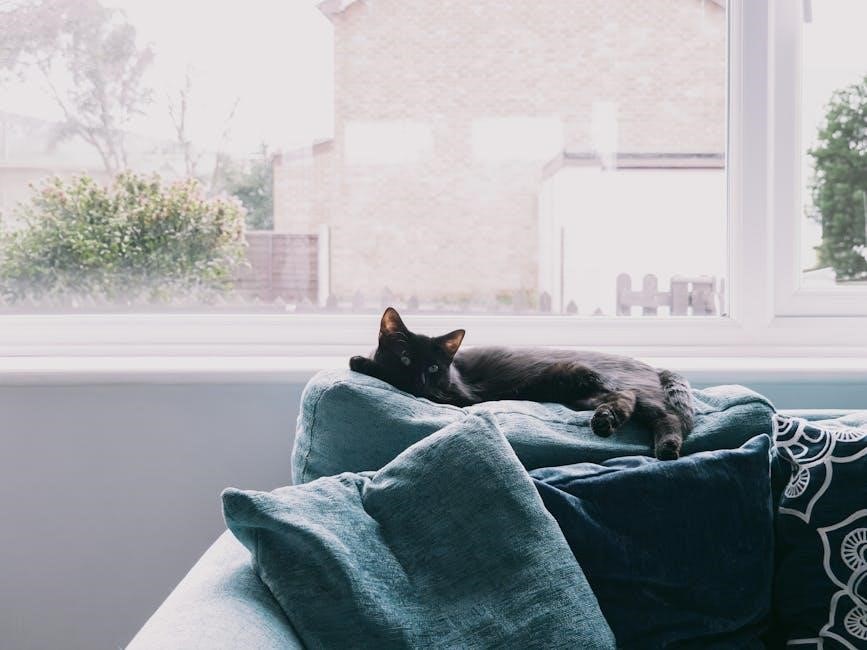The Black Cat: An Edgar Allan Poe Analysis
Edgar Allan Poe’s “The Black Cat” delves into the dark psychological themes of guilt and insanity‚ showcasing a man’s descent into madness. The story uses first-person narration to build characters while imparting a sense of horror and foreboding‚ exploring the depths of the human psyche.
“The Black Cat‚” a chilling tale by Edgar Allan Poe‚ unfolds through the eyes of an unreliable narrator on death row‚ reflecting on the events that led to his impending execution. He begins by professing his love for animals‚ particularly his black cat‚ Pluto. However‚ as he succumbs to alcoholism‚ his temperament shifts drastically‚ transforming him into a cruel and violent individual.
One night‚ in a drunken rage‚ he gouges out one of Pluto’s eyes‚ marking the beginning of a series of increasingly disturbing acts. Eventually‚ he hangs Pluto from a tree‚ an act that fills him with a profound sense of guilt‚ though he quickly represses it. Soon after‚ a similar black cat appears‚ bearing a white mark on its chest‚ which the narrator initially welcomes. However‚ his growing resentment towards the cat‚ coupled with his paranoia‚ intensifies his descent into madness.
In a fit of rage‚ when his wife attempts to stop him from harming the cat‚ he murders her with an axe. He then conceals her body behind a brick wall in the cellar. When the police investigate‚ the narrator confidently leads them through the house‚ only to be undone by a haunting wail emanating from behind the wall‚ revealing the cat and the gruesome truth.
Publication History and Context
Edgar Allan Poe’s “The Black Cat” was initially published in the August 1843 edition of The Saturday Evening Post. This places the story within the context of Poe’s prolific period of short story writing‚ a time when he was grappling with personal struggles and exploring the darker aspects of human nature in his fiction. The story later appeared in Poe’s 1845 collection of tales.
The 1840s were a turbulent time for Poe‚ marked by financial difficulties and personal tragedies. He frequently moved between cities‚ seeking literary success and stability. “The Black Cat” reflects the anxieties and psychological complexities that plagued Poe during this era. His life experiences‚ including his struggles with alcohol and his exposure to themes of death and loss‚ significantly influenced the story’s themes and tone‚ contributing to his obsession with dark romanticism.
The story’s publication in a popular magazine like The Saturday Evening Post allowed it to reach a wide audience‚ contributing to its enduring popularity. The context of its publication highlights the cultural interest in gothic and macabre themes during the 19th century‚ which Poe masterfully exploited in his works. The themes of domestic violence‚ alcoholism‚ and the supernatural resonated with readers‚ cementing “The Black Cat” as a notable work.
Themes: Insanity and Mental Deterioration
“The Black Cat” is a chilling exploration of insanity and mental deterioration‚ charting the narrator’s descent into madness. The story opens with the narrator proclaiming his sanity‚ a common trope in gothic literature that immediately casts doubt on his reliability. As the narrative progresses‚ his actions and justifications reveal a mind unraveling‚ consumed by irrationality and violence.
The narrator’s initial love for animals transforms into inexplicable cruelty‚ culminating in the mutilation and murder of Pluto‚ the black cat. This shift marks a critical stage in his mental decline‚ showcasing the disintegration of his moral compass. The introduction of the second cat‚ an almost identical replacement for Pluto‚ further exacerbates his paranoia and guilt‚ pushing him closer to the brink of madness.
The story masterfully portrays the insidious nature of mental deterioration‚ illustrating how seemingly small acts of cruelty can escalate into uncontrollable rage and violence. The narrator’s inability to recognize his own madness underscores the theme‚ highlighting the self-delusion that often accompanies mental illness. Poe uses the first-person narrative to immerse the reader in the narrator’s distorted perspective‚ creating a sense of unease and horror as we witness his slow but certain descent into the abyss of insanity. The tale explores the capacity of the human mind to observe its own deterioration.
Themes: Alcoholism and Domestic Violence
Alcoholism and domestic violence are central‚ disturbing themes in Edgar Allan Poe’s “The Black Cat‚” intertwined to depict a horrifying cycle of abuse and self-destruction. The narrator’s initial fondness for animals and his wife gradually erodes as he succumbs to the influence of alcohol‚ triggering a transformation into a violent and irrational individual. This descent highlights the destructive power of addiction and its devastating consequences on personal relationships.
The story portrays a stark reality of domestic abuse‚ with the narrator’s drunken rages leading to acts of cruelty towards both his pets and his wife. His violence escalates from verbal abuse and neglect to physical assault‚ culminating in the ultimate act of domestic violence: the murder of his wife. The graphic description of these acts underscores the brutal reality of domestic abuse and its devastating impact on victims.
Poe masterfully connects alcoholism and domestic violence to illustrate a vicious cycle. The narrator’s alcoholism fuels his violent tendencies‚ while his acts of violence further exacerbate his feelings of guilt and remorse‚ leading him back to alcohol as a means of coping. This cycle traps him in a spiral of self-destruction‚ ultimately leading to his downfall. The story serves as a cautionary tale about the dangers of addiction and the devastating consequences of domestic violence‚ portraying the dark side of human nature and the destructive power of unchecked impulses. The negative effects of alcoholism are explored.
Themes: Superstition and the Supernatural
Superstition and the supernatural are interwoven threads in Poe’s “The Black Cat‚” contributing to the story’s chilling atmosphere and exploring the narrator’s descent into madness. The initial act of cruelty towards Pluto‚ the black cat‚ is followed by a series of increasingly inexplicable events‚ blurring the line between reality and the supernatural. The narrator’s growing paranoia and belief in omens and curses intensify the sense of dread and foreboding.
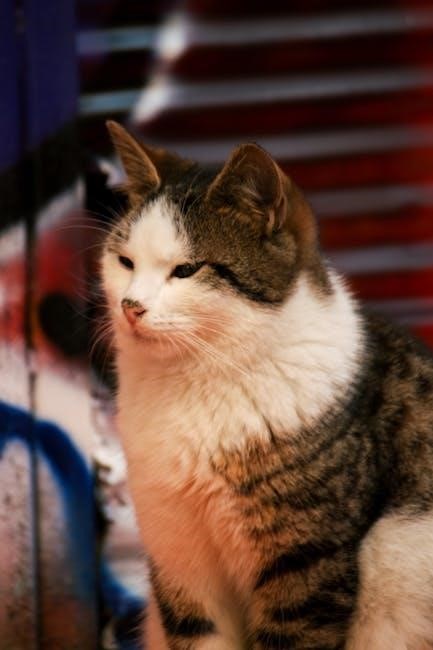
The appearance of the second cat‚ nearly identical to Pluto but with a distinctive white marking‚ further fuels the narrator’s superstitious fears. He interprets the cat’s presence as a manifestation of his guilt and a harbinger of impending doom. The white marking‚ resembling a gallows‚ becomes a symbol of his impending punishment‚ driving him deeper into despair and madness.
The supernatural elements in the story are not presented as objective truths but rather as products of the narrator’s disturbed mind. Whether the events are genuinely supernatural or simply figments of his imagination is left ambiguous‚ leaving the reader to question the nature of reality and the power of the human mind to create its own horrors. Poe uses superstition and the supernatural to heighten the suspense and explore the psychological depths of the narrator’s guilt and paranoia. The dark tone emphasizes these themes.
Gothic/Dark Romanticism Elements
“The Black Cat” exemplifies several key characteristics of the Gothic and Dark Romanticism literary movements. The story is steeped in an atmosphere of unease‚ disgust‚ and horror‚ creating a palpable sense of dread throughout. The dark tone and ominous language contribute to the overall mood‚ immersing the reader in the narrator’s deteriorating mental state. The presence of the supernatural‚ or at least the narrator’s perception of it‚ is another hallmark of the Gothic tradition.
Dark Romanticism emphasizes the darker aspects of human nature. The story explores themes of insanity‚ guilt‚ and the destructive power of the human psyche. The narrator’s descent into madness and his acts of violence reveal the capacity for evil that lies within individuals. Unlike traditional Romanticism‚ which celebrates the inherent goodness of humanity‚ Dark Romanticism acknowledges the presence of sin and depravity.
The setting also plays a significant role in establishing the Gothic atmosphere. The story unfolds in a decaying domestic space‚ reflecting the narrator’s own moral and psychological decay. The themes of domestic violence further amplify the dark undertones. The focus on the grotesque and the macabre‚ combined with the exploration of psychological torment‚ solidifies “The Black Cat” as a prime example of both Gothic and Dark Romantic literature.
The Unreliable Narrator
Edgar Allan Poe masterfully employs the unreliable narrator in “The Black Cat‚” blurring the lines between reality and delusion. From the outset‚ the narrator insists on his sanity‚ immediately casting doubt on his account. His self-proclaimed rationality is undermined by his increasingly erratic behavior and violent actions‚ leading the reader to question the veracity of his narrative. The reader is forced to interpret events through the lens of a distorted perspective‚ grappling with the narrator’s potential biases and fabrications.
The narrator’s struggle with alcoholism further compromises his reliability. His impaired judgment and altered perception of reality make it difficult to discern truth from fiction. The events he describes may be exaggerated or misinterpreted due to his intoxicated state. The reader must consider the possibility that the narrator is either deliberately deceiving them or genuinely unable to accurately recall the events.
As the story progresses‚ the narrator’s mental state deteriorates‚ making his account even more questionable. His descent into madness is marked by paranoia‚ irrationality‚ and a growing sense of guilt. The reader is left to piece together the truth from fragmented and potentially unreliable information‚ creating a sense of unease and uncertainty. The use of an unreliable narrator amplifies the story’s psychological horror‚ challenging the reader to confront the subjective nature of reality.
Symbolism: The Black Cat (Pluto)
In Edgar Allan Poe’s “The Black Cat‚” Pluto‚ the initial black cat‚ serves as a potent symbol representing a multitude of themes‚ including guilt‚ conscience‚ and the narrator’s deteriorating mental state. Initially‚ Pluto embodies the narrator’s affection for animals and his seemingly benevolent nature. However‚ as the narrator descends into alcoholism and madness‚ Pluto becomes a target of his abuse‚ symbolizing the corruption of his soul. The cat’s eventual mutilation and murder represent the narrator’s destruction of his own conscience and moral compass;
Pluto’s missing eye is particularly symbolic‚ suggesting the narrator’s inability to see his own moral failings. It represents a blindness to his own wickedness and a refusal to acknowledge the consequences of his actions. The name “Pluto‚” derived from the Roman god of the underworld‚ foreshadows the dark and destructive path the narrator will follow. The cat’s presence serves as a constant reminder of the narrator’s guilt‚ haunting him and driving him further into despair.
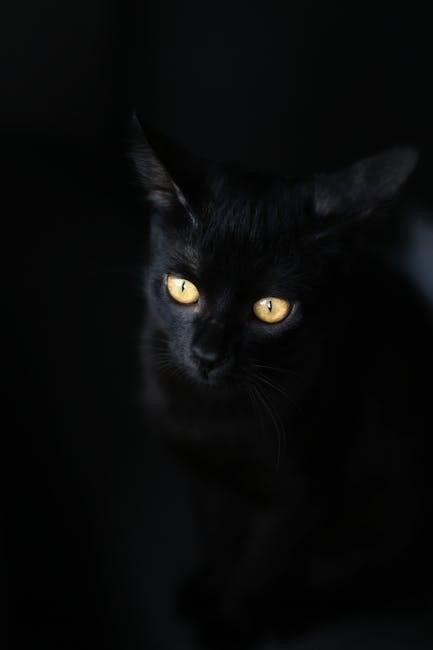
Furthermore‚ Pluto can be interpreted as a representation of the narrator’s “anima‚” the feminine side of his personality. His violent actions towards Pluto reflect his repressed emotions and inner turmoil. Ultimately‚ Pluto’s symbolism is complex and multifaceted‚ contributing to the story’s overall themes of psychological horror and the destructive nature of guilt. The cat’s presence is a constant reminder of the narrator’s depravity.
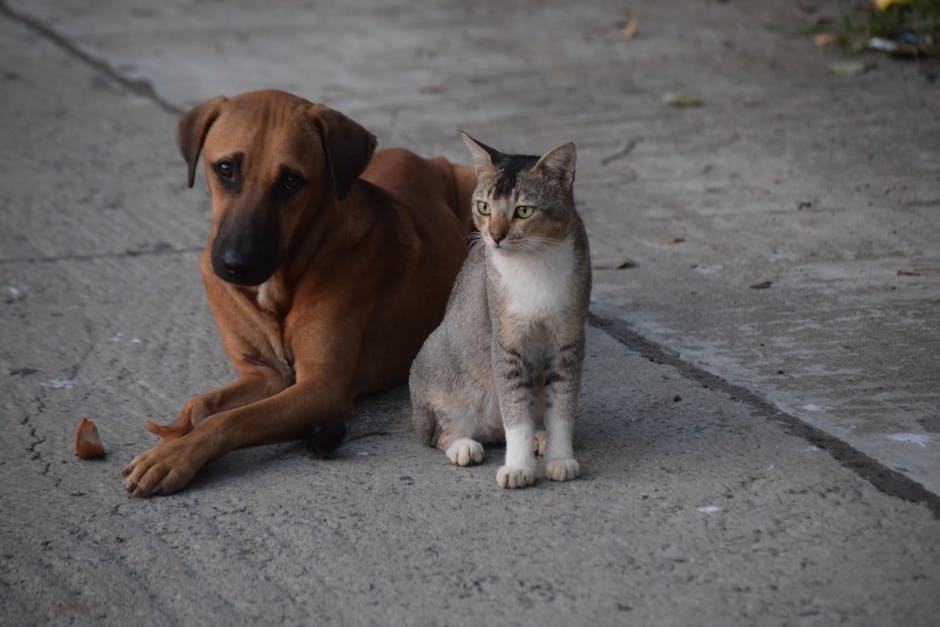
Symbolism: The Second Cat
The second cat in Edgar Allan Poe’s “The Black Cat” acts as a powerful symbol‚ amplifying the themes of guilt‚ and the supernatural‚ and mirroring the narrator’s descent into deeper madness. This cat‚ nearly identical to Pluto but with a white patch on its chest‚ represents the inescapable nature of the narrator’s past actions. The white patch‚ ironically resembling a gallows‚ serves as a constant‚ visible reminder of his crime and impending doom.
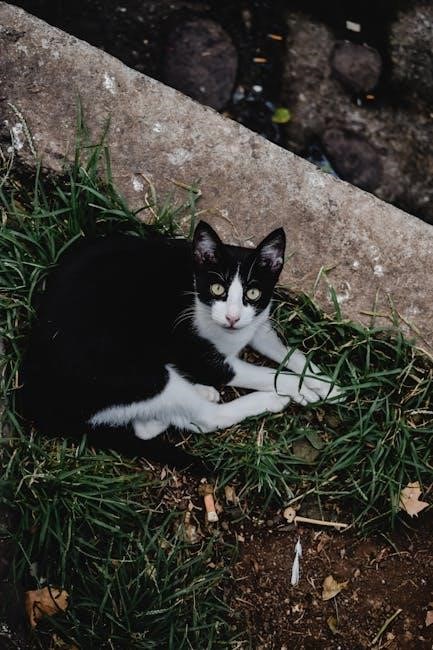
Unlike Pluto‚ the second cat initially inspires a sense of hope and companionship in the narrator. However‚ this feeling quickly turns to loathing as the cat’s presence intensifies his feelings of guilt and paranoia. The second cat becomes a symbol of the narrator’s inescapable conscience‚ a physical manifestation of his internal torment. Its unwavering gaze and constant presence serve as a perpetual accusation‚ driving the narrator to the brink of insanity.
The cat’s ultimate entombment within the wall‚ along with the narrator’s murdered wife‚ symbolizes the complete suppression of his conscience and the final triumph of his dark impulses. The second cat embodies the idea that one cannot escape the consequences of their actions‚ and that guilt‚ like a persistent phantom‚ will always find a way to surface. This cat is representative of the narrator’s inability to run from his own demons.
Psychological Interpretation: Guilt and Repression
“The Black Cat” by Edgar Allan Poe provides a rich landscape for psychological interpretation‚ particularly concerning the themes of guilt and repression. The narrator’s actions‚ driven by alcoholism and a perverse spirit‚ are not simply acts of violence but manifestations of deep-seated psychological turmoil. His initial love for animals transforms into inexplicable cruelty‚ suggesting a repressed anger or frustration that finds an outlet in violence. The murder of Pluto‚ the first cat‚ is a symbolic act of self-destruction‚ representing the narrator’s attempt to destroy the parts of himself he despises.
The subsequent appearance of the second cat‚ nearly identical to Pluto‚ underscores the inescapable nature of guilt. The narrator’s attempt to replace Pluto with a new companion fails‚ as the second cat only serves as a constant reminder of his transgression. The white mark on its chest‚ resembling a gallows‚ becomes a symbol of impending doom‚ further fueling his paranoia and driving him towards madness. His final act of violence‚ the murder of his wife‚ is a desperate attempt to silence his conscience and repress the overwhelming guilt that consumes him.
However‚ the narrator’s efforts to repress his guilt ultimately fail‚ as the cat’s presence‚ even after being entombed within the wall‚ leads to his eventual downfall. The story illustrates the destructive power of repressed emotions and the inability to escape the consequences of one’s actions‚ highlighting the human mind’s capacity to observe its own deterioration.
Freudian Analysis
A Freudian analysis of Edgar Allan Poe’s “The Black Cat” reveals the story as a manifestation of the narrator’s internal conflicts and repressed desires. The violence‚ terror‚ and murder within the narrative are not simply gratuitous acts but symbolic representations of the narrator’s psychological state. The black cat‚ Pluto‚ can be interpreted as a representation of the id‚ the primal and instinctual part of the psyche. The narrator’s initial affection for Pluto suggests a harmonious relationship between his ego and id.
However‚ as the narrator succumbs to alcoholism‚ his superego‚ the moral compass‚ weakens‚ allowing his id to dominate. The act of gouging out Pluto’s eye symbolizes the narrator’s attempt to blind himself to his own conscience. The second cat‚ bearing a resemblance to Pluto‚ represents the return of the repressed‚ a constant reminder of his guilt and the inescapable nature of his primal urges. The white mark resembling a gallows foreshadows his impending punishment‚ a manifestation of his superego’s judgment.
The ultimate act of violence‚ the murder of his wife‚ signifies the complete breakdown of the narrator’s ego and the triumph of his id. His attempt to conceal the body within the wall can be seen as a symbolic attempt to bury his repressed desires. Ultimately‚ the cat’s revelation of the crime represents the inability to escape the consequences of one’s unconscious drives.
Literary Devices: First-Person Narrative
Edgar Allan Poe masterfully employs the first-person narrative in “The Black Cat‚” creating a chilling and intimate portrayal of a man’s descent into madness. The story’s power lies in its ability to draw the reader into the narrator’s distorted perspective‚ blurring the lines between reality and delusion. By presenting the events solely through the narrator’s eyes‚ Poe constructs a sense of unease and unreliability. The reader is forced to question the narrator’s sanity from the very beginning‚ as he insists on his own rationality while recounting increasingly disturbing acts.
The first-person perspective allows Poe to explore the narrator’s internal thoughts and emotions‚ revealing the gradual disintegration of his soul. We witness his transformation from a loving animal enthusiast into a violent and perverse individual. The narrative voice becomes increasingly erratic and fragmented‚ mirroring the narrator’s mental state. This subjective viewpoint amplifies the horror of the story‚ as the reader is trapped within the narrator’s nightmarish reality.
The use of “I” allows Poe to manipulate the reader’s sympathies and create a sense of complicity. We are privy to the narrator’s justifications and rationalizations‚ even as his actions become increasingly abhorrent. This narrative strategy forces us to confront the dark potential within ourselves‚ blurring the distinction between observer and participant in the narrator’s descent into depravity.
